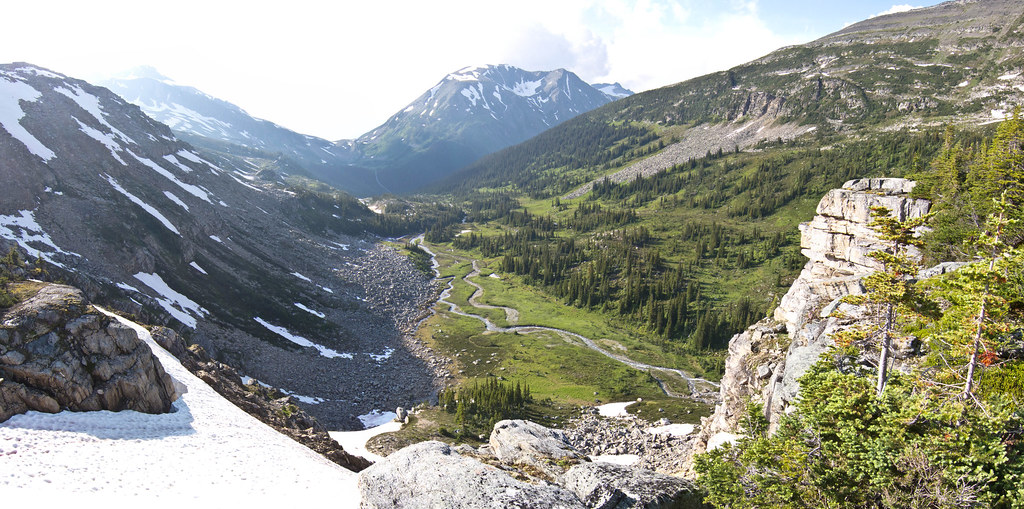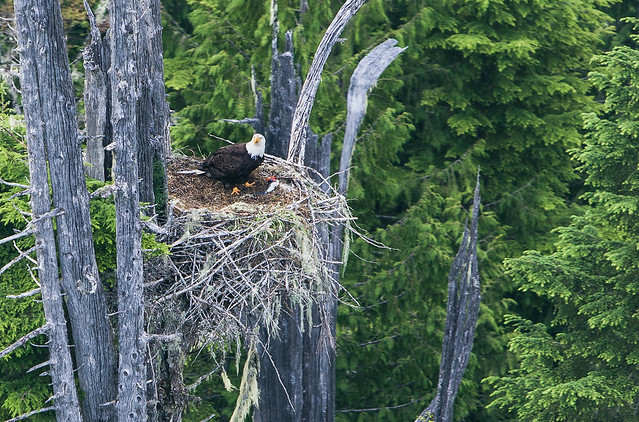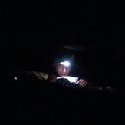|
11000 feet up on some mountain (I would later find out it was named Wet Peak) I hear a "Baaah" and turn to see this adorable little guy He (or she, I dunno) was so cute!
|
|
|
|

|
| # ? Apr 23, 2024 13:15 |
|
First off, thanks to everyone in the thread, reading through it has been very informative and entertaining for me. I'm definitely getting the itch to get back to the outdoors after being a cityboy for 6-7 years, and I have a question: Anybody have any recommendations for shelter and a sleeping system for someone who's 6'7"? Any other specific gear recommendations for excessively tall people are also welcome. I have to sleep diagonal on a queen size bed to not have my feet hanging off, I have never personally seen any space-efficient camping gear that would be comfortable for me. I've always used 2-4 person tents for car camping and music festival type stuff to fit me and my gear +/- a friend. I think I'm leaning toward a hammock right now, in part because products like the Warbonnets advertise they comfortably fit people up to 6'8". I'd be interested to know of cheaper models that might also be comfortable at my height (and weight- ~245lb), but I'm not terrified of the price tag on a Warbonnet (might have to skimp on the tarp a little). In researching them, I also learned about quilts which are attractive to me because it hasn't been easy in the past to find sleeping bags that fit me well. I have an old 20deg North Face bag that barely fits me, but I've unzipped it, used it like a quilt and slept directly on the pad/mattress almost every time I can remember because it was more comfortable that way (and it wasn't anywhere near 20deg outside). If I bought a ground tent, I don't think I would want a tarp-style because I'm not sure how soon I will actually buy trekking poles. They are on my radar, but if I can put together a 30ish pound pack for an overnight trip, which doesn't seem too hard from reading through the thread, I don't see myself rushing out for poles until I want to tackle some longer or more challenging hikes. So far I'm definitely a camping oriented person, not so much hiking. I like hiking out to cool places, but my main motivation is spending some relaxing time there rather than covering as much terrain as possible. Finally, I noticed several people recommended buying a smaller day-pack before worrying about a bigger pack for overnights. It's likely that until next spring I wouldn't actually plan an overnight hike, but if my goal is ultimately to prepare for overnights and longer hikes, is it a bad idea to buy a bigger pack, pack it for overnights, and use it for day hikes as a sort of training tool? Ultimately I'd love to have several packs for different trips, but I also don't feel like I need a closet full of stuff to choose from for a while.
|
|
|
|
Im sure the suspense is ing everyone; I spent a couple hours walking around REI with a variety of day packs on to which would work out for my intended purposes. Ended up buying an Osprey Stratos and a 3 liter bladder. Edit: wavering on returning it for the 26 after packing it with my chosen load out. What do you carry for first aid? More to the point should I cut the gauze and trauma bandage to save room? Ropes4u fucked around with this message at 00:27 on Jul 8, 2013 |
|
|
|
You can pick up little REI first aid kits for cheap. Keep them in a plastic bag.
|
|
|
|
Ropes4u posted:What do you carry for first aid? More to the point should I cut the gauze and trauma bandage to save room? Let's go over the basics: Water, snacks, raincoat, warm shirt, headlamp, first aid kit. Bonus items: sunscreen (instead of leaving it in the car, not instead of none at all, doofus), plant ID book, gloves, spare socks, victory beers. Edit: in my (prepackaged) kit I've got; athletic tape, bandaids, steril pads, ace bandage, scisors, antiseptic swabs, moleskin, and a small selection of pain pills. There's some other stuff in there, but I've never used it - and most of the stuff I've only ever used when we were at camp and I could have had a much larger kit in the car. Sometimes I store my iodine pills in it, and I usually keep a spork in it as well. Speleothing fucked around with this message at 03:50 on Jul 8, 2013 |
|
|
|
Time Cowboy posted:I climbed Slide Mountain... Wassup fellow Catskill Hiking Goon! It's nice to see another one on here, it seems that people are all too often focused on the Adirondacks and forget that the Catskills even exist. I've been mostly focusing on the Kaaterskill Range and North Lake area. This past Friday I did my first foray into the Windham area to get a better look at Blake Dome, Blachead, and Thomas Cole. Any experience with those? And most of all, have you ever attempted Kaaterskill High Peak?
|
|
|
|
Speleothing posted:What other stuff are you bringing along for a day hike? You should have plenty of room in a 20ish liter pack for a prepackaged first aid kit. Patagucci nano puff Rain jacket Zipped off pant legs Extra socks First aid - basic adventure pack plus a trauma bandage and compression gauze Epi pen - wife is allergic to bees Short length of thin line - 6mm E-blanket Bladder Water filter Fire kit Binoculars Camera Compass Headlamp Sun screen Bug repellent Wet wipes Food - peanut butter sandwiches - power bar - trail mix or dried fruit - drink mix I understand the trail to piles peak will be busy but this will not , I hope, be the last 14er we tackle and I would like to sort out my setup. I'm with four people (22-37) who have little experience in the mountains and would prefer to be over prepared.
|
|
|
|
Just got home from a quick backpacking trip up to Kristi Glacier, which is near McBride in northern BC (a couple hours out from Jasper). It was amazing and I recommend checking out the trails in the area of highway 16 if you're looking for something a bit more remote and less crowded than some of the popular trails in Jasper. The only issue is it's not nearly as well maintained as a national park trail, so we had to take our boots off and ford some creeks where the bridges had washed away  . Also there were some washouts on the road to the trailhead, and a rugged vehicle is probably necessary. . Also there were some washouts on the road to the trailhead, and a rugged vehicle is probably necessary. I got a lot of great pictures though:  Kristi 76 79 pano by Tagracat, on Flickr  Kristi 113 pano by Tagracat, on Flickr
|
|
|
|
Ropes4u posted:Patagucci nano puff Keep the camera & binocs out of the pack & ready-to-use. The group only needs one of most of what you're carrying. Split it up, see if you can get the filter & sunscreen, or repellent & first aid kit into someone else's pack. I get what you want wet wipes for, but do you actually use them? Go to a rib joint & get those little mini prepackaged ones or maybe slip three into a ziplock bag. How long is the 6mm line & what would you use it for - you can probably go thinner. You don't need a fire kit other than a full lighter & some gause from the first aid kit - everything on the ground in Colorado wants to burn already. I'm guessing your wife is also carrying an Epi pen, but I agree with the choice to carry an extra. You're hiking with friends, not guiding an them. Make them do some of the work.
|
|
|
|
Regarding the first aid discussion, take a wilderness first aid class! Most first aid kits are kinda useless if you don't know how to use them.
|
|
|
|
BeefofAges posted:Regarding the first aid discussion, take a wilderness first aid class! Most first aid kits are kinda useless if you don't know how to use them. Totally this! A first aid course will give you a better idea of what you want/need to carry, and the skills to use them. I know NOLS and WMA both do courses with dedicated wilderness components, but even a standard Red Cross type course can give you a leg up. The wilderness courses focus a lot on when you need to get out of the wilderness - when it's time to gently caress out of the backcountry and get to real help. That's probably the most valuable skill when you're in the woods: Knowing when to call it. My FAK contains a lot of the sexy stuff - SAM splints and quikclot and other assorted neato bits - but the stuff I use most often is the same stuff I use most often in my house. Look at your medicine cabinet/medicine drawer/medicine hole in the backyard. I have a small pouch dedicated to bandaids, ibuprofen, and Pepto Bismol because I use them constantly. And if you buy a prepackaged kit, open it up and go through it. Make sure you know what you have, when the medications expire, what you're comfortable using.
|
|
|
|
Does anyone know any good national parks in around the las angles area other than yosemite? Im trying to plan a trip over to la (from australia) and im thinking i would like to spend a few weeks hiking. Im a huge fan of anything involving mountains. Also what would you guys recommend for a tent. Im thinking of flying over and then just buying something in rei beacuse itll most likely end up cheaper then anything i can buy in australia and i don't have a hiking tent here atm anyway.
|
|
|
|
Are there any "on the trail" remedies to help prevent foot swelling? We have a multi-day hiking trip coming up in a few weeks, and when we did this last year my toes started to chafe at the very end because my feet had finally filled my boots. I bought some super padded hiking socks this time, but I'm not sure how much they will help. Our final day is the longest one so I just have to hobble back to the parking lot, but I'd like to know if there's anything extra I can do.
|
|
|
|
SpitztheGreat posted:Wassup fellow Catskill Hiking Goon! It's nice to see another one on here, it seems that people are all too often focused on the Adirondacks and forget that the Catskills even exist. I've been mostly focusing on the Kaaterskill Range and North Lake area. This past Friday I did my first foray into the Windham area to get a better look at Blake Dome, Blachead, and Thomas Cole. Any experience with those? And most of all, have you ever attempted Kaaterskill High Peak? I live on Long Island, so the Catskills are just barely within my day-trip limits. Driving four or five hours each way kind of sucks, though, so I've only hiked there twice, the Slide Mountain trip and a long approach to Overlook Mountain from the north. That time one of my hiking buddies turned an ankle, so we had to turn around at Echo Lake. I'm still figuring out the geography of the place; all those names you mentioned are kind of familiar, but I couldn't put them on a map. I'm just barely in shape enough to do the Slide Mountain hike, so I hesitate to ask for recommendations. Last time I did, someone suggested the Tongue Mountain Range loop, which is way way beyond my current abilities. That said, what's a must-see hike in the Catskills for someone of my roundish build? I like views almost as much as I like flat easy hiking.
|
|
|
|
Ropes4u posted:
Pike's Peak is seriously long for a day hike, at least the trail I took, Barr trail, I think. I think it was 25 miles round trip. Your list of stuff should get you there and back, but I think if I went up that mountain again, I'd do it as an overnight trip. I remember that as a really long and brutal hike. Good luck.
|
|
|
|
So I had a pretty epic short hike in the coastal mountain range in nowhere British Columbia, just east of the northern-most tip of Vancouver Island. I'm still working on processing the photos but here's one I got on the way there. 
|
|
|
|
Ropes4u posted:What do you carry for first aid? More to the point should I cut the gauze and trauma bandage to save room? Medkit chat! Gauze is one of the only items in those kits I do carry. Gauze is important and, combined with tape or cloth, will make you just about any bandage. Much of the poo poo in a store-bought first aid kit isn't necessary. My semi-minimalist kit is -gauze -medical or climbing tape ^^^^these 2 items will serve as most any bandage you need (thougha few bandaids for little cuts could be good too) -duct tape (take a few yards and fold it into a 2" square, sticky-side-to-nonsticky-side) -some electrolyte stuff and some sugar -soap -hopefully you have a knife/scissors elsewhere in your pack; if not, then do so -nitrile gloves and/or an un-lubed condom (at the very least, they make a good squirt gun for irrigating a wound) -moleskin (duct tape can work okay for this too, though) Stuff I maybe should carry but don't -a sam splint -an iodine wipe can be good for cleaning AROUND a wound, not in it Ditch the space-blanket and bring garbage bags instead - they are way more widely useful. Pills are another story. Bring what you want for comfort. But mostly, you'll be good with ibuprofen, benadryl, immodium (diahrrea = dehydration), and if you've got any NON-drowsy perscription painkillers, they can come in handy if someone has to hobble out on a broken leg (though giving them to someone is illegal, so just, you know, "drop" them or something). A very quick source of caffeine or an "emergency inhaler" or any stimulant will help if someone is having anaphelealeleptic shock and nobody has an epi-pen - it might keep the person alive long enough for benadryl to kick in (15 minutes). Better to have an epi-pen though. Most importantly, especially with a somewhat minimalist medkit, you really need to know how to use it. Take a wilderness first aid class. 
|
|
|
|
Tagra posted:Are there any "on the trail" remedies to help prevent foot swelling? We have a multi-day hiking trip coming up in a few weeks, and when we did this last year my toes started to chafe at the very end because my feet had finally filled my boots. I bought some super padded hiking socks this time, but I'm not sure how much they will help. Our final day is the longest one so I just have to hobble back to the parking lot, but I'd like to know if there's anything extra I can do. Wearing a sock liner can make a big difference. I also carry some Bag Balm which is really greasy heavy lotion type stuff and slather it all over my feet at the end of a day of hiking. Also making sure your boots are nice and broke in and not brand new out of the box right before your hike.
|
|
|
|
Did a few miles on the AT and Laurel Falls at GSMNP back in March: Laurel Falls:  Note: I messed up the color settings on my phone for these as it was snowing off and on and the lighting was changing  Newfound Gap looking back at 441:   The AT almost at Charlie's Bunion covered in snow, it seems to have melted/refroze several times so it was really slippery:  Snowing in the valley (again, sorry for the odd color problems): 
|
|
|
|
Aliass posted:Does anyone know any good national parks in around the las angles area other than yosemite? Im trying to plan a trip over to la (from australia) and im thinking i would like to spend a few weeks hiking. Im a huge fan of anything involving mountains. Joshua Tree, Sequoia, Kings Canyon, Death Valley, and the Mojave National Preserve are all really nice. Also, they're not national parks, but the Angeles National Forest and San Bernardino National Forest are nice, and they're much closer to LA. An REI tent should work just fine, like the Half Dome or Quarter Dome. The employees at REI can help you pick something.
|
|
|
|
Tagra posted:Are there any "on the trail" remedies to help prevent foot swelling? We have a multi-day hiking trip coming up in a few weeks, and when we did this last year my toes started to chafe at the very end because my feet had finally filled my boots. I bought some super padded hiking socks this time, but I'm not sure how much they will help. Our final day is the longest one so I just have to hobble back to the parking lot, but I'd like to know if there's anything extra I can do. Elevation of affected areas is a pretty general purpose way to reduce swelling. At the end of each day, take off your shoes, lie down, and prop up your legs on a log or rock or something.
|
|
|
|
Find a nice cold stream/lake and soak your feet after a day of hiking. Also, thick socks might end up being more of a problem in the long run because you'll have less space for your feet to expand in your boots if they do swell. I'd probably aim for better cushioned or better fitting boots/shoes before I rely on thick, cushioned socks to reduce impact
|
|
|
|
alnilam posted:Medkit chat! Might add those I have splints but decided against them. I love my space blankets like no other blanket, but I do have a couple trash bags to add to the load. Speleothing posted:Keep the camera & binocs out of the pack & ready-to-use. The group only needs one of most of what you're carrying. Camera and Binocs will be in my waist pockets. I was hesitant to split up the stuff because I "stupid ego, man related excuse here" but will do so before we go. Good advice on carrying two epi pens, swimgus posted:Pike's Peak is seriously long for a day hike, at least the trail I took, Barr trail, I think. I think it was 25 miles round trip. Your list of stuff should get you there and back, but I think if I went up that mountain again, I'd do it as an overnight trip. I remember that as a really long and brutal hike. Good luck. We are taking the train back to the bottom. I have been taking first aid courses for work and the military since the 80's but if the wife wants to keep peak bagging or hiking after this trip a modern wilderness course is a must for us both. Thanks!
|
|
|
|
On the contrary WFA isn't really that much better than a standard First Aid course. Your current training is probably just as good, if you've kept it up-to-date. Wilderness First Responder is where the specialist training starts.
|
|
|
|
Speleothing posted:On the contrary WFA isn't really that much better than a standard First Aid course. Your current training is probably just as good, if you've kept it up-to-date. If there is a WFR class nearby (colorado) I'm in for the experience.
|
|
|
|
Time Cowboy posted:I live on Long Island, so the Catskills are just barely within my day-trip limits. Driving four or five hours each way kind of sucks, though, so I've only hiked there twice, the Slide Mountain trip and a long approach to Overlook Mountain from the north. That time one of my hiking buddies turned an ankle, so we had to turn around at Echo Lake. I'm still figuring out the geography of the place; all those names you mentioned are kind of familiar, but I couldn't put them on a map. In that case stay away from Panther Mountain and Kaaterskill High Peak. Panther is routinely mentioned as one of the top hikes in the area, and (just like Slide) its remote location does not deter legions of hikers from making their way to it. While the hike has probably the best views the Catskills can offer (certainly the best I've seen) the trail is sadly not worth the work. Yes, the views are 5 stars but Irene and the other rain storms have clearly impacted the trail more than many others; it's completely washed out. I don't mean it's just hard to follow or in need of maintenance, I mean it doesn't exist anymore and is nothing more than a river of small to medium size boulders for much of the hike. Honestly it was one of the least fun hikes I've ever done, which was too bad. NOTE- I did this hike about a month and a half ago. Kaaterskill High Peak has a few different approaches, but it's considered hard from any angle so it's probably best to avoid it. HOWEVER, that area, the Kaaterskill range and North/South Lake area are packed full of trails for all ranges of abilities. The center of the area is Palenville, it gives you access to a bunch of hikes and is fairly easy to get to from the Thruway. From the DEC parking lot just outside of the village you can hike to the north along the Escarpment Trail which will bring you into the Grand Hotel Area and eventually to North/South Lake. These trails are easy to moderate and with great payoff, great views and lots of history/sites like the old Kaaterskill Hotel Site. If you go south of the DEC parking lot the trail is MUCH more difficult, but brings you to Poets Ledge, one of the top spots to see in the Catskills. It's probably a 7 mile round trip hike to PL, hard, but manageable if you take your time. If you keep going up from PL you'll come to some great waterfalls, Twilight Park, and eventually Kaaterskill High Peak. I've been doing trails almost exclusively in the Palenville area for almost a year and I've yet to get bored. If I were you I'd start there, but I do realize that it will be a hell of a drive for you. Closer to home, and on the east side of the Hudson, I hear that Putnam County has lots of good hiking. Might be worth checking out.
|
|
|
|
With hiking footwear there is almost no instance in which the shoe is too loose in the toebox unless you are sloppy in the heel (sliding forward / slipping out) or tripping over the length. You want it to fit snug in the heel, secure around the instep but have plenty of room up front. Hiking is hard on your feet, even more so when you have a pack. You need the room to not only accomodate the foot swell reasons mentioned above, but also to allow the toes to splay out for stability via proprioception and to allow the transverse and longitudinal arches of the foot to flatten out under load like a leaf spring to absorb shock. If you restrict the foot's ability to get wider to absorb impact forces, the force still has to go somewhere and ends up leading to additional fatigue and soreness of the feet, legs, hips and back.
|
|
|
|
SpitztheGreat posted:Kaaterskill High Peak has a few different approaches, but it's considered hard from any angle so it's probably best to avoid it. Ah, something to work toward! I mean, my mid-range goal is to be able to do Marcy without dying, but this might be a good step toward that goal. SpitztheGreat posted:I've been doing trails almost exclusively in the Palenville area for almost a year and I've yet to get bored. If I were you I'd start there, but I do realize that it will be a hell of a drive for you. I was thinking about the North South Lake area; I'm still at the guidebook stage with the Catskills, and that's one of the big recommended hikes in the Falcon guide. My big trip next month will probably be an overnight trip into the Adirondacks -- my first overnight AND my first time setting foot in the 'Dacks! -- but if I can find time to get away this fall, the Palenville area will definitely be at or near the top of the list. Which brings up the question of fall crowds. If I pulled into a trailhead at, say, 10 am on a beautiful autumn Saturday, would I be screwed, or would I at least be able to park? SpitztheGreat posted:Closer to home, and on the east side of the Hudson, I hear that Putnam County has lots of good hiking. Might be worth checking out. Just for fun (I love playing with maps), I made up this map of my hikes over the last three or so years, ever since I got back into hiking. You can see that, while I haven't ventured into Fahnestock, I've spent a fair amount of time doing the "classic" Putnam County hikes -- Bull Mountain, Anthony's Nose, Breakneck Ridge, etc. So I can attest that Putnam is pretty good. Sadly, I'm getting a tiny bit bored of the Hudson Highlands.
|
|
|
|
I'm hesitant to do the Adirondacks without a partner, in the Catskills I can be pretty sure of Cell reception in most areas. And in case i don't have reception I know that I'm alot closer to civilization if anything serious were to happen. In the Adirondacks you will never have cell phone reception and you could very well wonder forever and not see civilization. Yea, I'm exaggerating a little, but not much. It's a beautiful area, but one to be taken very seriously. As for parking, Palenville is criminally underused, in fact that whole area that I mentioned is. Parking can get a little tricky if you swing around to North South Lake but not too bad and there's lots of places to park. Around Palenville the only problem is that the DEC parking lot is tiny and is the only place to park. Whatever you do, do not park on the road or anywhere else, I hear Palenville is notorious for towing and ticketing. http://catskillmountaineer.com/index.html The link above is a really good website for hiking in the Catskills. Regularly updated with new trails and very detailed in its descriptions. As for the High Peak, good luck, I tried it from Palenville last fall and had to turn around. It's an 11 mileish round trip and it's not well marked. I believe that until about 10 years ago it was an unofficial trail, and today it's not heavily used or maintained. In fact, I don't think it even has a box to register with now that I think about it. Anyways, if you attempt it from Palenville you will be attempting the single greatest elevation gain in the Catskills. The High Peak is not the tallest peak, but from where you start you will gain something like 2,500 feet.
|
|
|
|
Speleothing posted:On the contrary WFA isn't really that much better than a standard First Aid course. Your current training is probably just as good, if you've kept it up-to-date. I disagree - regular first aid classes assume help is coming soon and that you are within reach of an ambulance. My WFA class focused a lot on preparing someone for evacuation, when to evacuate, and even a little bit of mid-term care to keep someone healthy if your evac lasts several days. Also lots of general tips on wilderness nutrition and "taking care of yourself (so you don't need first aid)." Regular first aid tends to focus on what to do until the pros arrive. Maybe mine was more comprehensive than most? It was two full days. Anyway the other poster took military first aid which might be similar to WFA?
|
|
|
|
I took a WFR course last summer and I can say that I am very glad that I did. The information I learned there will be invaluable to me throughout my entire life, and I recommend to anyone that does a lot of backpacking/outdoor trips to look into it. On another note, thanks to everyone that gave me suggestions for a tent. I tried to get the Terra Nova but it was sold out so I ordered a Fly Creek 2. I think one of the main complaints people have (the tent isn't long enough) won't effect me because I am 5'5" and the girlfriend is 5'4". Will be testing it out in the white mountains in a few weeks.
|
|
|
|
The more I think a out it the more I think a WFA or WFR class would be good. My wife has t had any training, but he k laws everything  , and most of today's first aid is geared towards - an ambulance or medivac is on the way. , and most of today's first aid is geared towards - an ambulance or medivac is on the way.Any suggestions for the Denver eastern colorado area?
|
|
|
|
http://www.nols.edu/portal/wmi/courses/
|
|
|
|
Nice, think we will start with the three day course. Though I admit that two weeks in boulder sounds fun..
|
|
|
|
SOLO also offers it through Apex Mountain School out that way: http://www.apexmountainschool.com/courses/wilderness-medicine/wilderness-first-responder/ Edit: WFR, that is.
|
|
|
|
There are several of companies that offer them.
|
|
|
|
Anyone hiked the Dolly Sods or good areas around eastern West Virginia? Want to plan some trips a little further away from the DC area vvv - Nice Levitate fucked around with this message at 03:24 on Jul 10, 2013 |
|
|
|
I'm leaving to drop my car off at Whitney portal and take YARTS to yosemite valley this saturday and starting the John Muir Trail next monday oh my god I'm so excited!
|
|
|
|
You lucky S.O.B.! I would love to do the JMT some day. Why'd you choose to hike southbound? Any particular reason?
|
|
|
|

|
| # ? Apr 23, 2024 13:15 |
|
slartibartfast posted:You lucky S.O.B.! I would love to do the JMT some day. I believe it's the most common route for multiple reasons. The first day on trail will take us from 4000 to 10,000 ft elevation I believe, which is a lot less likely to make us altitude sick than 4,000 to 14,500 at the summit of Mt Whitney. And doing Mt Whitney on the last day of the trek at sunrise will be amazing. I think most people do it southbound (sobo). On top of the fact there's no place for resupplies in the southern half of the JMT (without hiring a scheduled packer or mule to a pass or hiking out to a trailhead out of your way) except Muir Trail Ranch which is 100 miles from Whitney Portal, that's the largest load of food on the trip, 12-15 lbs/ 7 to 10 days, to take with you on the first heavy day up to the highest point on the trail.
|
|
|






























